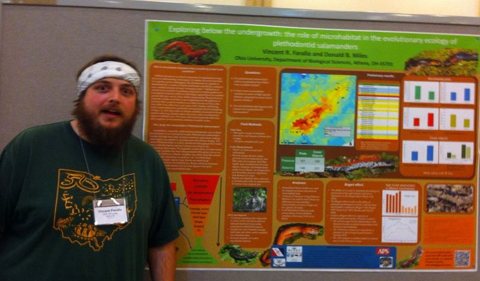 Biological Sciences graduate student Vincent Farallo presented a paper on “Exploring Below the Undergrowth: The Role of Microhabitat in the Evolutionary Ecology of Plethodontid Salamanders” at the 2014 Joint Meeting of Ichthyologists and Herpetologists July 30 to Aug. 4 in Chattanooga, TN.
Biological Sciences graduate student Vincent Farallo presented a paper on “Exploring Below the Undergrowth: The Role of Microhabitat in the Evolutionary Ecology of Plethodontid Salamanders” at the 2014 Joint Meeting of Ichthyologists and Herpetologists July 30 to Aug. 4 in Chattanooga, TN.
His co-author was Dr. Donald Miles, Professor of Biological Sciences at Ohio University.
Abstract: One of the primary factors affecting the distribution of a species is the availability of suitable habitat. However, ascertaining those aspects of a habitat linked to population occurrence and persistence is a critical task. Salamanders of the family Plethodontidae are an important component of forest floor ecosystems. Habitat use in this group has been studied extensively, but the majority of studies are either narrowly focused, or involve analyses based on broad scale climate data. Habitat occupancy by salamanders is influenced by the availability of suitable microhabitats, which is the appropriate spatial scale for individual activities associated with survival and reproduction. The generation of large-scale multi-species inferences requires incorporating microhabitat data on a broad spatial-scale. We are gathering microhabitat data over a large portion of the range of plethodontid salamanders from West Virginia south to Georgia. These data will be used to address three questions: 1) Is there significant variation in microhabitat variables in areas of differing species richness? 2) Are microhabitats phylogenetically conserved in plethodontid salamanders or within subclades of Plethodontidae? 3) Can behavioral compensation act to maintain constant physiological performance across habitats that vary in thermal and hydric quality? We began data collection in 2012 and will continue through 2015. Variation in mic




















Comments